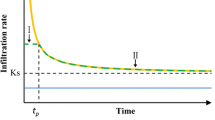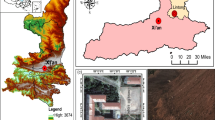Abstract
In order to get the law of rainwater infiltration and the law of progressive water damage, the slope of Tianshang bridge foundation in Yunnan Province of China is taken as the engineering basis. The site investigation of the damaged slope is carried out. The traditional Green-Ampt model is improved by considering the ponding effect of dynamic water flow on the slope surface. Based on the variation characteristics of wetting front obtained by the improved infiltration model, the progressive failure process of slope with continuous infiltration is simulated by FLAC3D software. The results show that the water damage of Tianshang bridge slope is mainly caused by the slope absorbing a lot of rainwater in a short time, which has obvious time discontinuity characteristics in time, and shows obvious multi-layer progressive failure characteristics in failure space. The wetting front characteristics obtained by the improved Green-Ampt infiltration model are more consistent with the engineering practice. The water accumulation effect of surface water gradually weakens with the increase of the wet front depth. The slope failure develops gradually from the toe to the top and from shallow to deep. The intermittent failure characteristics provide surplus time for the engineering treatment, the gravel soil slope should be treated after a small-scale water damage occurs.







Similar content being viewed by others
References
Akan AO, Atabay S (2015) Green and Ampt infiltration model extended beyond rain duration. Water Environ J 29(4):515–522
Chen Y, Withanage KR, Uchimura T et al (2020) Shear deformation and failure of unsaturated sandy soils in surface layers of slopes during rainwater infiltration. Measurement 149:1–12
Chen W, Jiang M, Dai J, Ding B, Yin P (2021) A domino model based slope stability analysis method. Chin J Geotech Eng 43(01):112–120 (in Chinese)
Damiano E, Greco R, Guida A et al (2017) Investigation on rainwater infiltration into layered shallow covers in pyroclastic soils and its effect on slope stability. Eng Geol 220:208–218
Dong H, Li Z, Jiang X et al (2016) Indoor model test of gravel soil slope under heavy rainfall. J Saf Environ 16(004):236–241 (in Chinese)
Dong H, Huang R, Gao Q (2017) Rainfall infiltration performance and its relation to mesoscopic structural properties of a gravelly soil slope. Eng Geol 230:1–10
Fan W, Wei Y, Deng L (2017) Failure modes and mechanisms of shallow debris landslides using an artificial rainfall model experiment on Qin-ba mountain. Int J Geomech 18(3):04017157
Gutiérrez-Martín A, Herrada MÁ, Yenes JI et al (2019) Development and validation of the terrain stability model for assessing landslide instability during heavy rain infiltration. Nat Hazards Earth Syst Sci 19(4):721–736
Harianto R, Alfrendo SN, Eng CL et al (2010) Effects of groundwater table position and soil properties on stability of slope during rainfall. J Geotech Geoenviron Eng 136(11):1555–1564
Hou S, Ma S, Li H, Zhang H (2020) Research on progressive slope failure based on local stepwise reduction method of local strength. J Disaster Prevent Mitig Eng 40(01):72–78 (in Chinese)
Li C, Long X, Young MH et al (2015) Optimal parameters for the Green-Ampt infiltration model under rainfall conditions. J Hydrol Hydromech 63(2):93–101
Li Z, Luo X, Bi J et al (2020) Numerical modelling of internal erosion process in gravel soils based on the percolation analytical method. Environ Earth Sci 79(14):1–15
Liang Z, Liu H, Zhao Y et al (2020) Effects of rainfall intensity, slope angle, and vegetation coverage on the erosion characteristics of Pisha sandstone slopes under simulated rainfall conditions. Environ Sci Pollut Res 27:17458–17467
Liu Z, Yan Z, Qiu Z et al (2020) Stability analysis of an unsaturated soil slope considering rainfall infiltration based on the Green-Ampt model. J Mt Sci 17(10):2577–2590
Meng S, Yang Y (2019) Infiltration simulation with improved Green-Ampt model coupled with the wet zone partition function. J Hydrol Eng 24(5):04019014
Norambuena-Contreras J, Arbat G, García Nieto PJ et al (2012) Nonlinear numerical simulation of rainwater infiltration through road embankments by FEM. Appl Math Comput 219(4):1843–1852
Rolando O, Khalid F, Ikuo T (2004) Deformation behavior of sandy slopes during rainwater infiltration. Soils Found 44(2):15–30
Su H, Liu Z, Huang Z, Huang B (2015) A model test investigation on infiltration depth of soil slope under sustained rainfall. Chin Sci Pap 10(01):91–94 (in Chinese)
Xu J, Shang Y (2006) Influence of permeability of gravel soil on debris landslide stability. J Rock Mech Eng 11:2264–2271 (in Chinese)
Xu Q, Zhang L (2010) The mechanism of a railway landslide caused by rainfall. Landslides 7(2):149–156
Zeng L, Liu J, Zhang J et al (2018) Effect of colluvial soil slope fracture’s anisotropy characteristics on rainwater infiltration process. Adv Civ Eng 9:1–11
Zhang J, Li J (2018) Delay failure mechanism of rainfall-caused shallow landslide. Geotech Geol Eng 36(4):2293–2304
Zhang J, Zhu D, Zhang S (2020) Shallow slope stability evolution during rainwater infiltration considering soil cracking state. Comput Geotech 117:1–12
Acknowledgements
Thanks for the technical support provided by the School of Civil Engineering and the State Key Laboratory of Chongqing Jiaotong University, and thank China Overseas Construction Co., Ltd. for their assistance in obtaining the engineering materials of the Tianshang Bridge in Yunnan.
Funding
National Natural Science Foundation of China (41472262); Innovative research group of Chongqing University (cxqt19021); Key project of Chongqing Natural Science Foundation (cstc2020jcyj-zdxmx0012); The first batch of Chongqing outstanding talents innovation and leading talent project (cqyc201903026).
Author information
Authors and Affiliations
Contributions
BC completed the improvement of the Green-Ampt model and the writing of the article, QR directed the research content of this article, FW and BL completed part of the data processing work, WX participated in the project site survey work, and Renkun Zhang obtained the site data Provided help.
Corresponding author
Ethics declarations
Conflict of interest
The authors declare that they have no conflict of interest.
Additional information
Publisher's Note
Springer Nature remains neutral with regard to jurisdictional claims in published maps and institutional affiliations.
Rights and permissions
About this article
Cite this article
Chen, B., Ren, Q., Wang, F. et al. Progressive Failure Analysis of Slope Water Damage Based on Improved Green-Ampt Infiltration Model. Geotech Geol Eng 39, 5109–5118 (2021). https://doi.org/10.1007/s10706-021-01816-w
Received:
Accepted:
Published:
Issue Date:
DOI: https://doi.org/10.1007/s10706-021-01816-w




